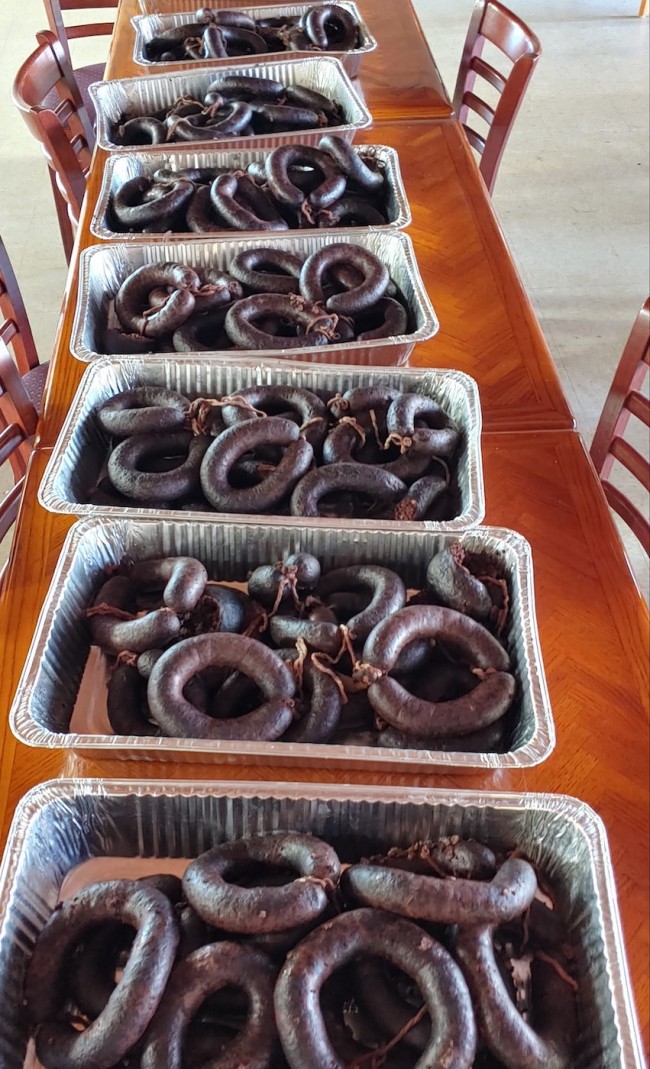Blood, Guts and Glory - making verivorstid (blood sausages)
Author: Ave Maria Blithe
Yes, we heathen Estonians take great pleasure in calling our traditional Yule food “blood sausage” instead of the more politically correct “black pudding”. After all - this delicious wurst in crackling casing IS made with fresh blood, minced meats, barley and secret herbs. We, the oldest peoples of Europe who have continually inhabited the same territory on the shores of the Baltic Sea for over 10 000 years (according to various archaeological excavations and carbon dating of artifacts) and proud of our Viking heritage do enjoy this “gruesome” delicacy. Especially in the times of militant veganism.
To us it symbolizes the sacred circle of life - using every last bit of a slaughtered farm animal, who got to enjoy a happy life in fresh air and green pastures. Rather than just feasting on the prime cuts of his loin, we collect the blood, chop up lesser cuts and use the intestines as sausage casings - thus honoring the life the beast gave up to feed us. Very much the same philosophy of Native Americans, who are also big on using every last bit of the harvested animal - from skin to bones and everything in between.
The making of blood sausage is not something to be done on a whim. It does involve an entire team and several days. Mind you - this is just the production of blood sausage. They still need to dry, cure and rest in a freezer before the day of actually baking them to be consumed. In other words - a labor of love. A very communal effort, best lead by someone with years of experience. Just like any ancient skill that is handed down directly from masters to apprentices. It is in that time honored tradition that we gather at Lakewood Estonian House in New Jersey, one of the few remaining active bastions of Estonian diaspora.
The scene that unfolds in the kitchen does indeed look like a crime scene - there is a huge galvanized tub. The size to water cattle or bathe babies and golden retrievers in. Into that go many pounds of cooked meats, sautéed onion, boiled barley and secret herbs. We stir it with paddles the size of boat oars. It is quite a workout; no gym needed that day. One is almost tempted to climb into this humongous tub and stomp the mixture with bare feet like Italians squashing grapes. I am told that it would not be a good idea. And then - the piece de la resistance - into that mixture jugs of fresh blood from a trusted local butcher gets poured. At this point, some faint-hearted avert their eyes, others more comfortable with gruesome realities of farm life start stirring the pot. The inevitable splatter of blood on the table and floor definitely conjure Dexter. Once this unholy mixture has been paddled enough, it gets divided into smaller batches to be chilled in the refrigerator.
A sausage machine gets set up while some cut string and others wash intestines. Let me explain - the pig intestines will be used as a natural casing for the blood sausage, they need to be clean, wet and pliable. The natural string needs to be cut into about foot long strips for tying up the filled casings, thus forming sausage links. The sausage stuffing machine looks like a giant meat grinder with a long tube, over which a strip of casing will be pulled like a certain super long latex preventative device. I assume that is why it is usually a man who is entrusted with this particular task. The chilled mixture will now be forced into this press and tube and casing - a delicate task usually handled by a woman as it needs to be held firmly yet gently. Needless to say, the entire procedure is accompanied by various adult jokes, not suitable to innocent ears.
The sausages now need to be boiled in huge pots. To test their doneness, it has to be pricked with a huge sewing needle. If it still squirts blood, it is not done. If not, it can be lifted out out to cool. Erik Must, the chef extraordinaire of Lakewood Estonian House has a designated needle for this pivotal task – attached to a piece of string and a real bullet like a fancy keychain. Needless to say (pun intended) I declare this a bullet-proof method of never loosing this particular needle.
We Estonians might seem like a reserved bunch to outsiders but get us together participating in one of our time-honoured tasks rooted in history and communal spirit mixed with laughter will soon fill the room. It just takes coed sauna or stuffing pig intestines with blood and barley mixture instead of superficial cocktail hour small talk.








